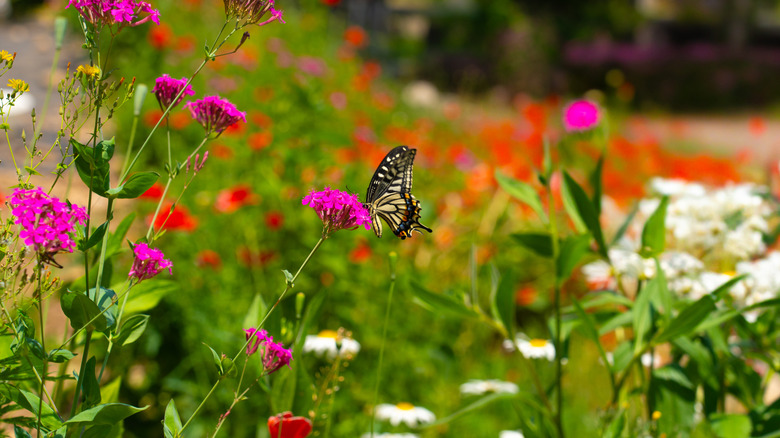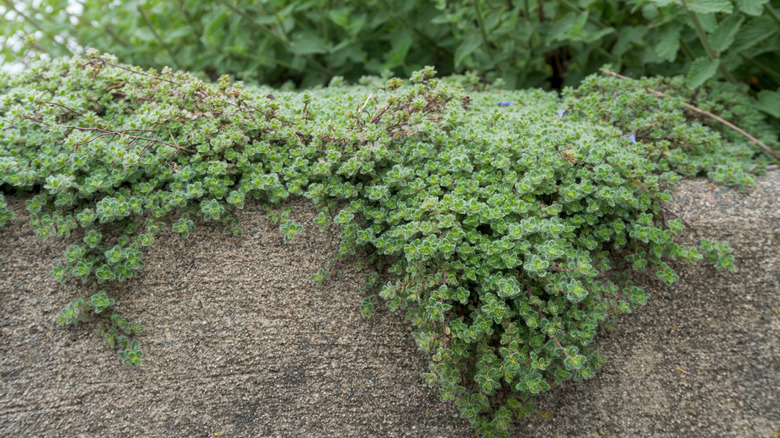The Drought-Resistant Ground Cover That Will Bring Pollinators To Your Yard
For most homeowners, it probably feels like the search for the perfect ground cover is truly never-ending. Whether you need a plant that's deer-resistant, drought-tolerant, or pollinator-friendly, the wide array of options can be a bit overwhelming for inexperienced gardeners. Some varieties grow too aggressively, while others demand constant attention to maintain their lush and vibrant appearance. But woolly thyme (Thymus pseudolanuginosus) quietly checks all the boxes without drawing too much attention.
With silvery leaves and delicate pink flowers, this fuzzy, aromatic plant makes itself right at home between stepping stones or along garden pathways. Even better, it thrives in both hot and cold climates, as well as dry areas where other plants typically struggle to survive, forming a soft, scented carpet that attracts pollinators with minimal effort. Woolly thyme is more than just a pretty filler — it's a resilient addition to your yard or garden. The plant tolerates drought, poor soil quality, and neglect without much of a fuss, making it perfect for gardeners who don't have the greenest thumb.
Once established, it forms a soft, silvery mat that stays compact and never truly looks unruly. When summer arrives, tiny pink blossoms appear, each one buzzing with life as bees and butterflies drift in to feed. The blooms may be small, but together they create a soft haze of color and movement that instantly lifts an outdoor space. Beneath all that beauty, the dense foliage helps the soil retain moisture, keeping your garden healthier without the extra effort. It's a plant that grows slowly and typically stays in place, meaning it won't overtake its neighbors or crowd out other flowers in your pollinator-friendly garden.
Everything you need to plant & care for woolly thyme
Planting woolly thyme is refreshingly straightforward — and the less you mess with it, the happier your plant will seem. This hardy perennial is originally from the Mediterranean, so you'll want to plant it in an area that mimics those conditions: full sun, well-draining, slightly rocky soil, and dry surroundings. Amend heavy clay soil with a bit of sand or gravel before planting to prevent water from pooling around the roots.
Once planted, water consistently, yet lightly, for the first few weeks to help it establish, then reduce the watering schedule. After that, woolly thyme thrives on minimal care, often doing best when it is mostly left alone. Overwatering or fertilizing too heavily can do more harm to your plant than good, so it's one of those plants where forgetting about it is part of the recipe for success.
The low-maintenance appeal continues when it comes to upkeep. Woolly thyme rarely needs pruning, but a light trim after the flowers bloom can help it stay dense and cushiony – think of it as more of a tidying ritual rather than an aggressive cutback. If your goal is to encourage more pollinators, you can let a few sections flower fully each season rather than trimming everything at once. Those pinkish clusters are a magnet for bees and butterflies, and by extending the blooming period, you can keep these pollinators coming back to your garden. Mix in other thyme varieties to stagger flowering times and boost biodiversity. During the summer, you'll want to avoid walking on it too often, as it can crush flowers and prevent them from opening fully. However, the plant itself tolerates occasional foot traffic once the flowers have faded.

